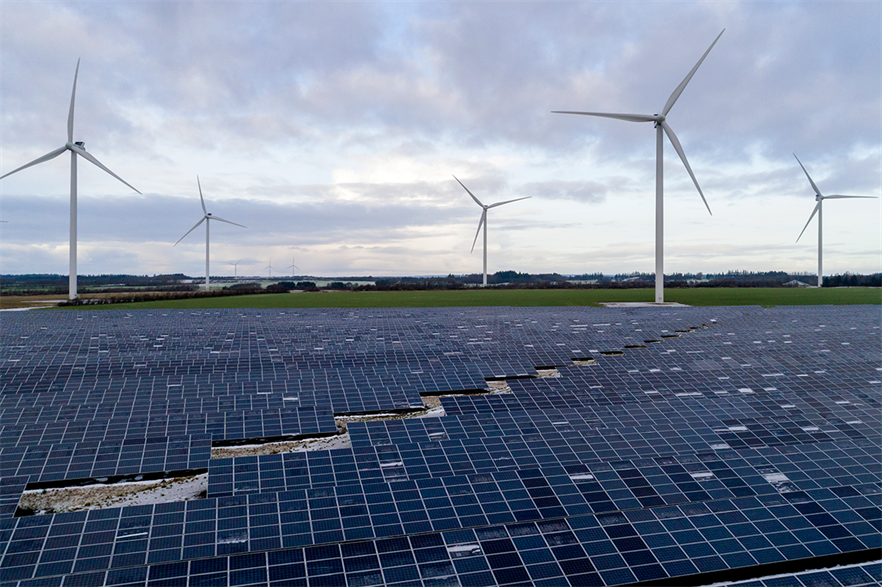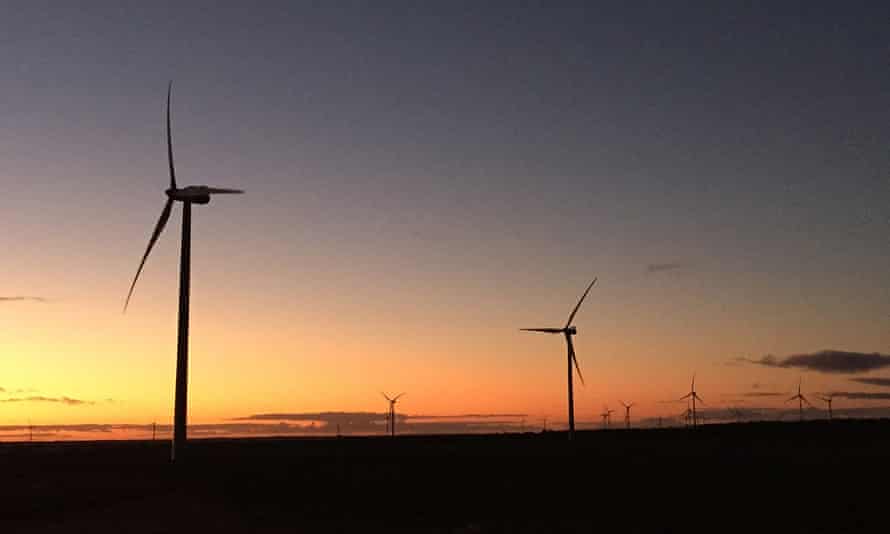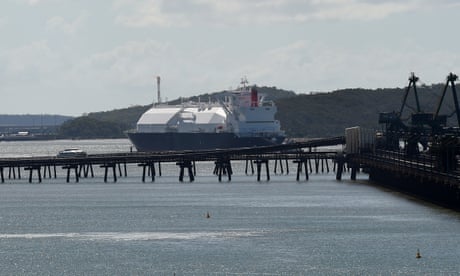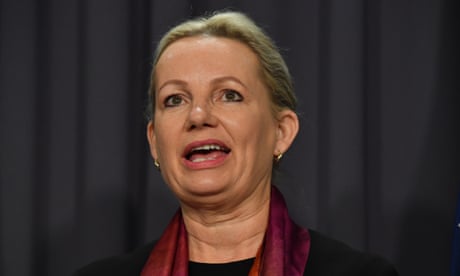Plans unveiled for 50GW wind- and solar-to-green hydrogen
13 July 2021 by Craig Richard
Hong Kong and Australian developers plan world’s largest green hydrogen facility near coast of Western Australia

Wind and solar hybrid work well in regions where resources complement each other (pic: Vestas)
An international consortium has unveiled plans to use 50GW of wind and solar PV capacity in Western Australia to produce green hydrogen and green ammonia.
The Western Green Energy Hub would be built across 15,000km2 in the south-east of the state – a region with an optimal diurnal profile for renewable energy, with consistently high levels of wind and solar over a 24-hour period, its developers claim.
It would consist of 30GW of wind and 20GW of solar PV capacity feeding up to 28GW of electrolysers, a spokeswoman told Windpower Monthly.
If built, it would become the world’s largest green hydrogen facility – larger than the 45GW wind- and solar-to-green hydrogen planned by German developer Svevind in Kazakhstan.
InterContinental Energy, CWP Global and Mirning Green Energy claim that the A$70 billion (US$52 billion) Australian project could produce up to 3.5 million tonnes of green hydrogen or 20 million tonnes of green ammonia each year.
They would provide these green fuels domestically within Australia, while the project’s location near the coast would enable international export as well.
This green hydrogen and green ammonia will meet massive future demand from multiple sectors, the developers added. Such sectors include co-firing in power generation – the burning of more than one material at once for power – shipping, heavy industry such as steel, chemicals and mining, as well as aviation.
The developers plan to finance the project themselves and are in talks with potential offtakers in various sectors.
They plan to make a final investment decision after 2028, and believe the first phase – of an unspecified capacity – could be operational by 2030.
Hong Kong-based developer InterContinental Energy and Australian counterpart CWP Renewables will work with first nations land owners on the project, they explained.
Co-developer Mirning Green Energy Limited is a wholly owned subsidiary of the aboriginal peoples group Mirning Traditional Lands Aboriginal Corporation. It will have a “meaningful” equity stake in the project and a permanent seat on the consortium’s board, InterContinental and CWP explained.
Big plans
InterContinental Energy and CWP Global’s subsidiary CWP Renewables are also working together on a separate 26GW clean energy hub in Western Australia.
However, the Australian environment department recently rejected plans for the second 11GW phase of this complex over potential impacts on wetlands and migratory bird species. The developers are now working to better understand the department’s concerns and amend the project accordingly.
An international consortium has unveiled plans to use 50GW of wind and solar PV capacity in Western Australia to produce green hydrogen and green ammonia.
The Western Green Energy Hub would be built across 15,000km2 in the south-east of the state – a region with an optimal diurnal profile for renewable energy, with consistently high levels of wind and solar over a 24-hour period, its developers claim.
It would consist of 30GW of wind and 20GW of solar PV capacity feeding up to 28GW of electrolysers, a spokeswoman told Windpower Monthly.
If built, it would become the world’s largest green hydrogen facility – larger than the 45GW wind- and solar-to-green hydrogen planned by German developer Svevind in Kazakhstan.
InterContinental Energy, CWP Global and Mirning Green Energy claim that the A$70 billion (US$52 billion) Australian project could produce up to 3.5 million tonnes of green hydrogen or 20 million tonnes of green ammonia each year.
They would provide these green fuels domestically within Australia, while the project’s location near the coast would enable international export as well.
This green hydrogen and green ammonia will meet massive future demand from multiple sectors, the developers added. Such sectors include co-firing in power generation – the burning of more than one material at once for power – shipping, heavy industry such as steel, chemicals and mining, as well as aviation.
The developers plan to finance the project themselves and are in talks with potential offtakers in various sectors.
They plan to make a final investment decision after 2028, and believe the first phase – of an unspecified capacity – could be operational by 2030.
Hong Kong-based developer InterContinental Energy and Australian counterpart CWP Renewables will work with first nations land owners on the project, they explained.
Co-developer Mirning Green Energy Limited is a wholly owned subsidiary of the aboriginal peoples group Mirning Traditional Lands Aboriginal Corporation. It will have a “meaningful” equity stake in the project and a permanent seat on the consortium’s board, InterContinental and CWP explained.
Big plans
InterContinental Energy and CWP Global’s subsidiary CWP Renewables are also working together on a separate 26GW clean energy hub in Western Australia.
However, the Australian environment department recently rejected plans for the second 11GW phase of this complex over potential impacts on wetlands and migratory bird species. The developers are now working to better understand the department’s concerns and amend the project accordingly.
Plan to build world’s biggest renewable energy hub in Western Australia
A site in WA the size of greater Sydney has been chosen for the $100bn project to convert wind and solar power into green fuels
 Wind turbines on a property near Merredin, Western Australia. An international consortium has selected a site in Australia’s south-west to build the Western Green Energy Hub. Photograph: Calla Wahlquist/The Guardian
Wind turbines on a property near Merredin, Western Australia. An international consortium has selected a site in Australia’s south-west to build the Western Green Energy Hub. Photograph: Calla Wahlquist/The Guardian
Graham Readfearn
@readfearn
Tue 13 Jul 2021 03.59 BST
An international consortium wants to build what would be the world’s biggest renewable energy hub in Australia’s south-west to convert wind and solar power into green fuels like hydrogen.
The group of energy companies announced the proposal over a 15,000 sq km area that could have a 50 gigawatt capacity and cost $100bn.
An area bigger than the size of greater Sydney has been identified in the south-east of Western Australia with “consistently high levels of wind and solar energy”.

Australia’s export credit agency gave 80 times more to fossil fuel projects than renewables
Guardian Australia understands the Western Green Energy Hub (WGEH) could cost about $100bn.
The project’s 50GW capacity compares to the 54GW of generation capacity of all the coal, gas and renewables plants currently in the national energy market, which includes all states except WA and the Northern Territory. Australia’s biggest coal plant is just 2.9GW.
InterContinental Energy, CWP Global and Mirning Green Energy Limited announced plans for the mega project on Tuesday, saying it wants to build the scheme in three phases to produce up to 3.5m tonnes of green hydrogen or 20m tonnes of green ammonia each year.
Guardian Australia understands the consortium is looking to produce the first fuels from the project by 2030, and will look to construct an offshore facility to transfer fuels onto ships.
The consortium – which includes an Indigenous-owned energy company – said it wanted to tap into a global market for green hydrogen it expects will be worth US$50tn by 2050. About 30GW of the hub would focus on wind, with the rest coming from solar power.
Hydrogen and ammonia produced at the hub would be destined for use in power stations, shipping, heavy industry and aviation.

Environment minister rules huge renewable energy hub in WA ‘clearly unacceptable’
The hub would be larger than a 45GW renewables project announced by German company Svevind Energy and planned for Kazakhstan, reported to be the world’s biggest renewables project proposed so far.
Last month, Australia’s environment minister Sussan Ley rejected a plan for a 26GW hub in the north of WA for “clearly unacceptable” impacts on threatened migratory species and internationally recognised wetlands.
In a statement, Trevor Naley, chairman of the Mirning Traditional Lands Aboriginal Corporation and a board member on the consortium, said: “As First Nations land owners, the Mirning people are excited to hold such an integral and defining stake in this historical partnership with WGEH. This partnership, through robust governance and a seat at the table for Mirning people, will provide opportunities never before available to Indigenous corporations.”
Brendan Hammond, chairman of WGEH said the proposal was “historic on two fronts” for its scale and its partnership with traditional owners.
“It is an honour and a privilege to be involved in this groundbreaking project,” he said.
WA’s hydrogen minister Alannah MacTiernan told the West Australian the proposal was “truly massive” and said the state was positioned to be a major contributor to global decarbonisation.
The newspaper said the consortium had secured a licence from WA’s McGowan government to complete site surveys and research to pursue a business case for the project.
A site in WA the size of greater Sydney has been chosen for the $100bn project to convert wind and solar power into green fuels
 Wind turbines on a property near Merredin, Western Australia. An international consortium has selected a site in Australia’s south-west to build the Western Green Energy Hub. Photograph: Calla Wahlquist/The Guardian
Wind turbines on a property near Merredin, Western Australia. An international consortium has selected a site in Australia’s south-west to build the Western Green Energy Hub. Photograph: Calla Wahlquist/The GuardianGraham Readfearn
@readfearn
Tue 13 Jul 2021 03.59 BST
An international consortium wants to build what would be the world’s biggest renewable energy hub in Australia’s south-west to convert wind and solar power into green fuels like hydrogen.
The group of energy companies announced the proposal over a 15,000 sq km area that could have a 50 gigawatt capacity and cost $100bn.
An area bigger than the size of greater Sydney has been identified in the south-east of Western Australia with “consistently high levels of wind and solar energy”.

Australia’s export credit agency gave 80 times more to fossil fuel projects than renewables
Guardian Australia understands the Western Green Energy Hub (WGEH) could cost about $100bn.
The project’s 50GW capacity compares to the 54GW of generation capacity of all the coal, gas and renewables plants currently in the national energy market, which includes all states except WA and the Northern Territory. Australia’s biggest coal plant is just 2.9GW.
InterContinental Energy, CWP Global and Mirning Green Energy Limited announced plans for the mega project on Tuesday, saying it wants to build the scheme in three phases to produce up to 3.5m tonnes of green hydrogen or 20m tonnes of green ammonia each year.
Guardian Australia understands the consortium is looking to produce the first fuels from the project by 2030, and will look to construct an offshore facility to transfer fuels onto ships.
The consortium – which includes an Indigenous-owned energy company – said it wanted to tap into a global market for green hydrogen it expects will be worth US$50tn by 2050. About 30GW of the hub would focus on wind, with the rest coming from solar power.
Hydrogen and ammonia produced at the hub would be destined for use in power stations, shipping, heavy industry and aviation.

Environment minister rules huge renewable energy hub in WA ‘clearly unacceptable’
The hub would be larger than a 45GW renewables project announced by German company Svevind Energy and planned for Kazakhstan, reported to be the world’s biggest renewables project proposed so far.
Last month, Australia’s environment minister Sussan Ley rejected a plan for a 26GW hub in the north of WA for “clearly unacceptable” impacts on threatened migratory species and internationally recognised wetlands.
In a statement, Trevor Naley, chairman of the Mirning Traditional Lands Aboriginal Corporation and a board member on the consortium, said: “As First Nations land owners, the Mirning people are excited to hold such an integral and defining stake in this historical partnership with WGEH. This partnership, through robust governance and a seat at the table for Mirning people, will provide opportunities never before available to Indigenous corporations.”
Brendan Hammond, chairman of WGEH said the proposal was “historic on two fronts” for its scale and its partnership with traditional owners.
“It is an honour and a privilege to be involved in this groundbreaking project,” he said.
WA’s hydrogen minister Alannah MacTiernan told the West Australian the proposal was “truly massive” and said the state was positioned to be a major contributor to global decarbonisation.
The newspaper said the consortium had secured a licence from WA’s McGowan government to complete site surveys and research to pursue a business case for the project.
No comments:
Post a Comment